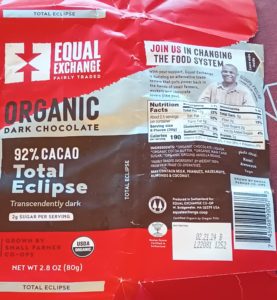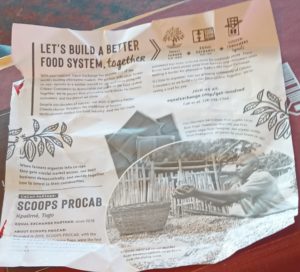12 Jun, 2023
Best of Clean & Green Links, Book Reviews, Clean & Green Club, Recommended Books
<!doctype html>
|
|
|
Shel Horowitz’s Clean and Green Marketing Tip: June 2023
|
|
|
|
|
|
|
Will Your Packaging Make the SECOND Sale?
|
|
|
Smart business owners recognize that present and previous customers (clients, patients, students, etc.) are gold. Studies say it costs anywhere from five to ten times as much to bring in a new cold prospect as to bring back an old one. So when you succeed in bringing that person back, you’ve cut your marketing cost by up to 90 percent—and increased your profit by the amount you didn’t need to spend on marketing. And when that person tells a friend, your customer acquisition cost is a very happy zero.
Last month, we discussed some tips to design your packaging so it helps prospects select you. Can that packaging also turn the one-time buyer into a repeater, and maybe even an unpaid ambassador for your brand?
Yes, you can! The same kinds of talking points that got them to take your product off the shelf or click the buy button the first time (see the list in the May newsletter) can also reinforce your brand’s relationship with them. And it works even better if you can make them feel special and honored because they’ve already purchased from you.
How do you make a customer feel special while reading a box printed in a run of thousands? Here’s one idea: use messaging in parts of the package that you can’t see until you open it. In the picture, you see a mild example: the inside flap from a box of Celestial Seasoning Bengal Spice herbal tea. I happen to love that tea blend, so I saw this because I bought the product.
But Celestial missed a chance to go much deeper to engage its customers. Why not use part of that inside space to create a VIP program or customers club? Give them reasons to join in community for a higher good? Provide them with even more ways to engage others and bring them into the fold?

Here’s how another premium natural-foods company, Equal Exchange, grabbed this ball and ran with it. The outside wrapper offers some hints: “Grown by small farmer co-ops” on both the front and (in small letters above the barcode) back panels; organic, worker-owner, and kosher/pareve certification seals—and a relatively large “Join Us in Changing the Food System” slug with a picture of one of their farmers, a description in very small type with not one but two emotional outreaches: it begins “With your support” and concludes with “puts power back in the hands of small farmers, workers and chocolate lovers (like you).” Most importantly, the “Join Us” banner ends in an arrow directing readers to the inside of the label. That in itself is a subliminal call to buy—because the only way to see what’s on the inside is to buy and open the bar.
Once opened, the entire inside is a well-designed, informative magazine-style page. It starts with a call-to-action banner with three small graphics declaring a partnership of the small co-ops, the company, and its customers. The three paragraphs under the banner layout their philosophy and history, describe the challenge of doing this work amid climate change and greedy multinationals, and then another call to action with both a URL and a phone number to get involved. Then, wrapped around drawings of the cacao plant and a photo of the product, a puff paragraph about co-ops and a description of the sources, followed by another photo of the same farmer and a description of his coop.
I’d only change a few things if they’d been my client:
- Tighten up some of the copy and make it more benefit-oriented (especially the part about the online community)
- Add more reasons to click through (maybe a special offer like a newsletter with coupons)
- Most importantly, I’d acknowledge the disability issue they’ve created by adding, in larger type, something like “Is the print here too small for you? Don’t worry—we’ve got your back (and your eyes). Visit [URL] to read it comfortably online. There’s not much room on a chocolate bar wrapper, but online, you can make the print as big as you like.” While I’m 66 and can read it easily, I’m aware that many people in their 40s and beyond have trouble reading small print.
So, if you sell stuff in a package, think about how you can grab the opportunity they missed. (And if you need someone to write those messages, talk to me (email or phone): https://goingbeyondsustainability.com/aboutshel/#contactus
|
|
|
|
|
|
|
|
|
|
|
Discover why Chicken Soup’s Jack Canfield, futurist Seth Godin, and many others recommend Shel’s 10th book, Guerrilla Marketing to Heal the World (and download a free sampler). Autographed and inscribed copies available. |
|
|
|
|
|
|
|
|
|
|
|
Leadership By Example by Frank Sonnenberg
|
|
|
Leadership By Example
by Frank Sonnenberg
I don’t usually review books that tell us what most of us already know—but I have a good reason to make an exception for Leadership By Example. This book can make a real difference in the life of someone who has not been raised to pay attention to ethics or character. It provides tons of guidance and easy checklists to determine if you’re living your best life, or betraying yourself and others. Plus, it’s designed to be easy to read and not overwhelming, with short chapters, lots of white space, bold all-capitals for chapter headings and subheads. It doesn’t surprise me that Stephen M.R. Covey, author of The Speed of Trust (one of my favorite business books), endorsed it. (Disclosure: he also wrote a wonderful Foreword to my 2010 book Guerrilla Marketing Goes Green.)
And while most of the advice is very familiar (and in harmony with how I’ve chosen to live), quite a few pieces stand out as more unique and thought-provoking. A few examples:
- Others’ good fortune is NOT your misfortune (p. 8)—and others’ success doesn’t threaten yours (p. 97)
- Every time you complete a task, evaluate the positives, negatives, and what you could have done differently (pp. 43-44); poor results provide great lessons (p. 89)
- Short-term desires often interfere with long-term success (p. 80)
- If you ignore small issues, you risk turning them into emergencies (pp. 152-153)
- Rewrite your negative programming and self-messaging. Example: change “why them and not me?” to “if they can do it, so can I.” (p. 176)
- Instead of asking kids what they want to be when they grow up, ask what they want to accomplish (p. 189) [I think this is also a great question to ask grownups, by the way]
- “When writing the story of your life, don’t let anyone else hold the pen” (p. 200)
I’d love to see a movement to buy this book for people graduating high school, college, or MBA programs. And I sure wish someone had given a copy at the right moment to the 45ththth US president, whose life has been the exact opposite of how Sonnenberg would have us live ours.
|
|
|
|
|
|
About Shel
Speaker, author, and consultant Shel Horowitz of GoingBeyondSustainabiity.com helps businesses find the sweet spot at the intersections of profitability with environmental and social good — creating and marketing profitable products and services that make a direct difference on problems like hunger, poverty, war, and catastrophic climate change. His 10th book is Guerrilla Marketing to Heal the World.
|
|
|
|
Powered by:

|